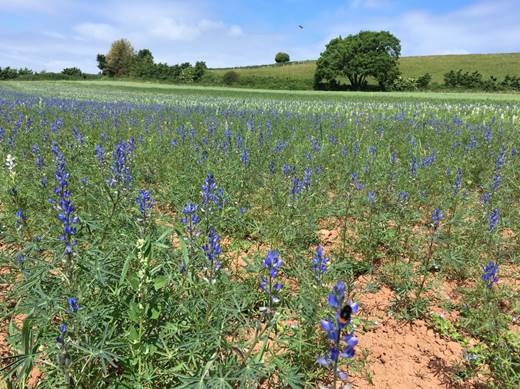Following national publicity last year, including an item on the BBC’s Countryfile, Mole Valley Farmers is looking for organic farmers interested in growing organics lupins as a cash crop.
Nigel Mapstone, the company’s organic feed development manager explains: “We are confident that lupins are a crop which can be successfully commercially grown in the UK and we are now looking for farmers to partner with us. After our two years of trials in 2017 and 2018, which saw the worst extremes of growing weather, we are confident that organic lupins are a viable alternative to organic beans as a protein feed source and a fertility building break in an organic rotation.”
The following is a guide to growing, based on the experiences of our trialists.
ORGANIC FARMERS GUIDE TO GROWING BLUE LUPINS
INTRODUCTION
In the UK lupins are used for crimping, ensiling and grain production. Blue and yellow lupins are described as sensitive to alkaline soils and a pH of 7.0 or less is ideal, but the varieties trialled grew well at pH up to 7.5. White lupins are more tolerant of alkaline conditions, growing well at pH 7.5. but unsuitable for combining in the UK and more susceptible to anthracnose.
CROP HUSBANDRY
Weed control and plant establishment are key to a good crop. Lupin seed should be tested for germination and anthracnose disease (Colletotrichum gloeosporioides or C.acutatum). Ensure only seed free from anthracnose infection is used and for this reason a derogation must be sought to use cleaned untreated conventional seed. Blue lupins tend not to carry the virus in the seed, as in most years infected plants tend to die before seed is set. Seed is planted with an inoculant to aid nodulation. The seed will normally be pre-treated with an organic approved inoculant but if not, inoculant should be mixed with the seed before drilling,
SEEDBED
Lupins are sensitive to soil compaction and sites should be selected accordingly. A fine seed bed will aid germination. When sowing lupins, the use of a stale seedbed technique ahead of establishment is essential for organic systems. Lupins will remove about 40-60kg/ha phosphate, 40-60kg/ha potash and 20-40kg/ha sulphate so manure should be applied to keep soils at suitable maintenance levels across the rotation. Sulphur requirement is likely to be similar to that of other pulse crops in the rotation.
DRILLING
Spring lupins should be sown in response to conditions not calendar dates, but typically seed should be sown in April into a warm (8°C), moist seedbed in order to promote fast establishment. Plant no deeper than 50mm, but a drilling depth of 30 – 40mm is recommended. Efforts should be made to place lupins into a good tilth and retain seedbed moisture. Rolling may be necessary, depending on soil type and weather forecast.
While actual seed rates will vary depending on grain weight, germination and expected losses, the guidelines for conventional crops are; approximately 90-110 seeds /m2 targeting 80-100 plants /m2. The field lab took the high end at 110 seeds/m2 but information from the LISA and LUKAA projects has suggested that for blue lupins seed rates of 125-150 seed /m2 can increase yield potential and improve weed suppression. Drill narrow row widths for weed suppression but wider rows (possibly up to 50 cm) can be used to allowed for inter-row mechanical weeding. Hoeing should take place as soon after emergence as possible and be repeated when weeds reappear in the trials accurate hoeing did not hamper growth of the lupins and our growers felt it may have improved growth rates.
HARVEST
As harvest date will normally be mid to late September, many weeds will already have died off. The problem occurs when a pre- harvest damp period causes late germination of weeds in hoed crops, in these cases a topper to remove tall weed seed heads such as fat hen may be useful.
BLUE VARIETIES
Regent
Type –blue/ narrow-leaved / spike / determinate / blue flower colour.
Tall, reduced branching, determinate variety, with good standing ability. Suitable for all combining in the Southern half of the UK, but also for crimping in other areas.
Iris
Type – blue / narrow -leaved / branching / semi-determinate / white flower colour.
Medium height, with a semi-determinate branching habit. Suitable for all combining in the Southern half of the UK and for crimping elsewhere.
Viol
Type – narrow-leaved / spike / determinate / very pale mauve flower colour
An early maturing, reduced branching, determinate variety, with good standing ability. May be grown for combining in all parts of the UK. It is claimed by the breeder to be an ultra-low alkaloid variety and to have Fusarium resistance.
Haags Blaue
Type – narrow-leaved / spike / determinate / blue flower colour.
A new variety in the UK, similar to Viol in growth habit and maturity.
SUMMARY
- Use inoculated seed.
- Not suitable for heavy soils.
- False fallows essential and a fine seedbed.
- Drill April, soil temp 8°C
- Increase seed rate to 125g/m2
- Inter-row hoeing will improve yields and reduce weed competition.
- If not hoeing, grow branching variety drilled with narrow row width.
To apply, please contact either matt.witt@molevalleyfarmers.com or james.trebble@molevalleyfarmers.com




